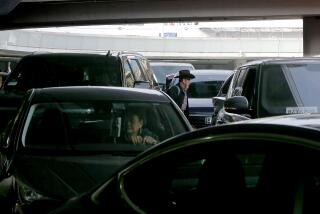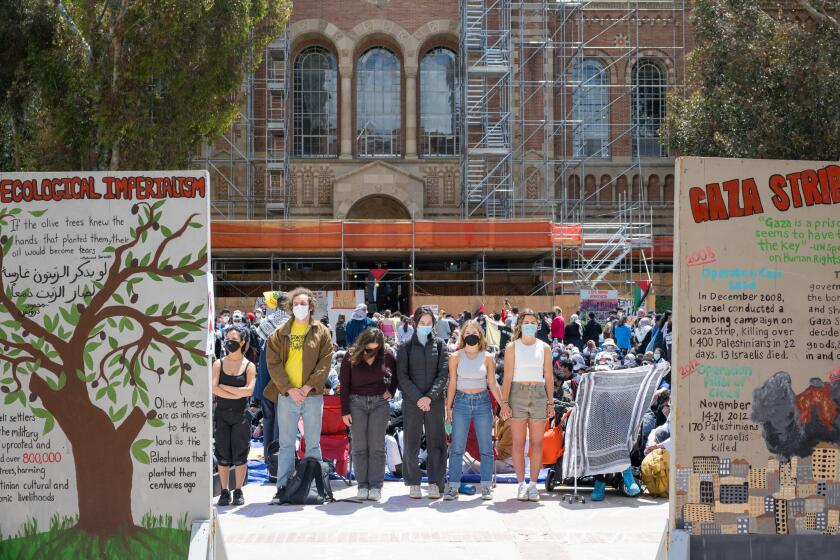Op-Ed: Nobody walks to LAX
I once tried to walk out of Los Angeles International Airport. This wasn’t easy.
I’d stepped off a flight with no luggage and decided on a whim to walk back to Venice, where I lived at the time. That seven miles turned out to be a breeze compared with navigating the maze of garages, rights-of-way and viaducts that confronted me once I got out of the terminal. Our grubby gateway to the world — like the city it serves — makes life rough on the ordinary pedestrian.
Los Angeles World Airports, the agency that runs LAX, is finalizing plans for one of its biggest structural changes in years: the $5.5-billion Landside Access Modernization Project. This will lasso all the rental car lots together into one big corral near Aviation Boulevard and eventually connect that — plus a passenger drop-off and future Metro station — to the horseshoe of terminals with a people mover. This is a long time coming. But the discussion is missing a critical element: giving LAX a human-scale connection to Century Boulevard.
A 2015 passenger survey shows that almost every LAX traveler arrives to get on a plane by using some other kind of vehicle. Private vehicles take 88% of them, vans and courtesy shuttles do 11%, leaving just 1% to get there via public transportation such as LAX FlyAway buses or the LAX/Aviation stop on Metro’s Green Line. Those that walk? Too few to be counted. LAX spokesperson Charles Pannunzio told me the only people known to walk into the airport were the pilots and flight attendants staying in one of the corporate hotels that stand at attention less than half a mile away. Indeed, you can sometimes spot them from your car with their dark-blue uniforms and wheelie suitcases. They’re walking to fly, for sure, but they are also walking to work.
Walking to the airport is a small private rebellion; a way of asserting one’s individuality before getting into a cattle-chute-like line to meet the TSA.
To be fair, airports in every American city have a schizophrenic relationship with foot traffic. Inside, they demand you walk, often long distances, from gate to gate. Some concourses are a modern flaneur’s dream with abundant retail shopping and people-watching.
Outside, it is the exact opposite. Airports seem to deliberately impede pedestrians. I tried to walk out of Miami International Airport last year and found it could only be done by chancing a jog down a sidewalk-less speedway. Other cities such as Dallas, Atlanta, Minneapolis and, especially, Denver, built their sky palaces far from population clusters, which is respectful in terms of noise and traffic , but makes life tough for those who choose the most basic form of movement.
The upcoming access project — scheduled to be at least partially finished in 2024 — would be an ideal time to improve what architects call “wayfinders,” the signs and other visual cues that point pedestrians in the right direction. If the airport encouraged more people to simply walk to and from the Century Boulevard hotels, it would reduce shuttle congestion and perhaps bring a little life to the dowdy corridor that welcomes visitors to Los Angeles before they reach the utter hell of the 405. A few well-placed directional signs might be enough to convince the skeptical that such a foot journey was even possible. We all have rolling luggage these days, after all.
My own walk out of the airport, though initially disorienting, yielded a pleasant surprise. After wandering through garages and past the arachnoid base of the shuttered Theme Building, I found an obscure sidewalk and headed toward the light — in this case the multicolored cylinders known as “the pylons.” Immediately in front of the pylons I discovered a diamond-shaped park immaculately gardened in Key West style and completely hidden from passing traffic. A flagpole bearing the legend “Gateway to the Pacific Rim” on a plaque and an inexplicable memorial to fallen workers from the U.S. Department of Agriculture stood at the center. Seemingly forgotten by everyone but the landscapers, it is probably L.A.’s best-manicured and least-visited park.
Walking to and from the airport is a small private rebellion, a union of high and low tech, a way of asserting one’s individuality just before getting into a cattle-chute-like line to meet the TSA agents. For fliers who live nearby, or those adventurous enough to walk from a long-term parking lot or the Green Line Metro stop, it will likely be the most liberating part of the trip. LAX should take some steps to make it easier.
Tom Zoellner is an English professor at Chapman University.
Follow the Opinion section on Twitter @latimesopinionand Facebook
More to Read
A cure for the common opinion
Get thought-provoking perspectives with our weekly newsletter.
You may occasionally receive promotional content from the Los Angeles Times.






